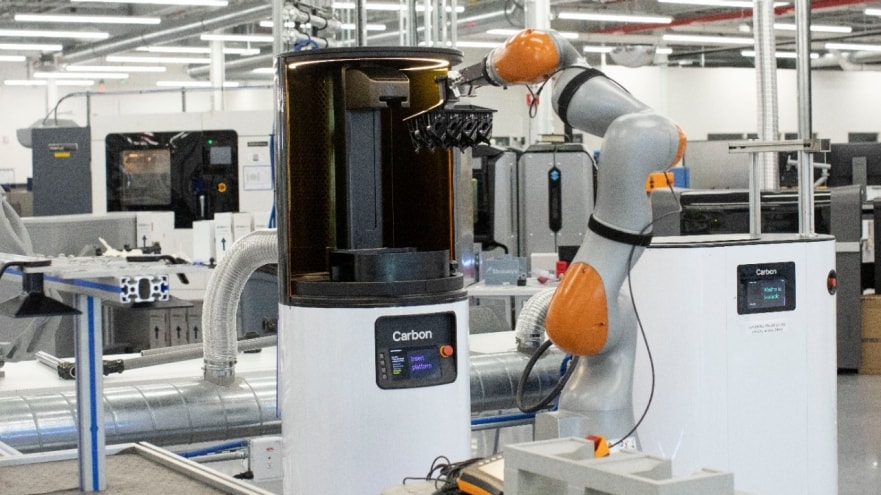Ford (NYSE: F)’s final production of its $500,000 road-going GT supercar will be a special edition tribute to the brand’s 2016 Le Mans (LM) win, in addition to the legendary “1-2-3” podium sweep in the same Grand Prix race from 1966 when all Ford drivers took the entire stage. Aside from the historical nostalgia of carrying the legacy of the celebrated model series Ford GT40, the new 2022 Ford GT LM Edition has added additional features using 3D printing technology.
With only 20 special-edition supercars available, the Ford Performance team looked for ways to embed the Le Mans podium-finishing spirit into the car. To do that, the team turned to AM. One of the additively manufactured details that distinguish this model is a bespoke alloy instrument panel badge which was 3D printed from an engine crankshaft once installed in the No. 69 Ford GT race car that took third place on the Le Mans 2016 podium. According to the company, once the Ford team located the crankshaft, they decided to ground down the piece into a powder and develop a special alloy to 3D print the new and distinctive component.
Also unique to the Ford GT LM is a 3D titanium-printed dual exhaust that features a cyclonic design inside the tips and hints at the twin-turbo 660 horsepower EcoBoost engine. Above the tips, a titanium GT LM badge is too 3D printed.
 2022 Ford GT LM Edition. Image courtesy of Ford.
2022 Ford GT LM Edition. Image courtesy of Ford.Previous Ford GT models also leveraged 3D printing for both prototypes and parts. For example, in 2015, the company unveiled its second-generation GT supercar model. It revealed how Ford designers used a series of prototypes to refine and perfect the square-shaped F1-style steering wheel that included integrated transmission paddle-shift controls and driver controls. The GT also had a pair of 3D printed lightweight structural components designed to reduce the weight of the car’s upward-swinging doors and chose laser 3D printing for the transmission paddle-shift controls. At the time, Ford also turned to 3D printing to develop the intake manifold on the EcoBoost race engine for the GT race car.
Considered among the first companies to strengthen its vehicle manufacturing with 3D printing, Ford bought the third 3D printer ever made in 1986. The stereolithography machine created an infinite variety of shapes and parts for faster, cheaper, and more efficient prototyping designs. Today, various AM technologies have been added to Ford’s 3D printing lab in Michigan, known as the Advanced Manufacturing Center, where the company uses a mobile robot to operate 3D printers autonomously and run 24-7. As a result, the facility has become what Ford describes as a “virtual sandbox for engineers” to design new types of parts never before thought possible and offered an ideal ecosystem for the company to file several patents for the technology in its drive to innovate.
 Using a mobile robot, Ford operates 3D printers autonomously. Image courtesy of Ford.
Using a mobile robot, Ford operates 3D printers autonomously. Image courtesy of Ford.As a result, in the last few decades, Ford printed more than 500,000 parts and saved billions of dollars and hours of work. Where it would have taken months and cost $500,000 to produce a prototype with traditional methods, a 3D printed part can be made in a matter of days or hours for just a few thousand dollars.
Ford GT series gets one final run
The first Ford GT models were built in 1964 with the release of the Ford GT40. With higher agility and aerodynamic shape, this ultimate sports car was launched to beat Ferrari from dominating endurance racing in Europe. Although this famous car left an incredible mark in racing history, the GT40 was discontinued by Ford in 1969. Forty years later, in 2004, the company decided to revive the GT nameplate with the launch of a whole new series of Ford GT cars. The latest model is part of the third and last generation to be produced by the company, which makes this truly a limited edition car.
Aside from the unique 3D printed parts, the Ford GT LM Edition boasts a race-livery exterior and an asymmetrically designed interior. Furthermore, with its carbon fiber body lacquered in Liquid Silver exterior paint, the limited-edition Ford GT LM is uniquely finished in either a red or blue theme throughout, honoring the red and blue race livery of the Le Mans winning No. 68 Ford GT of Sébastien Bourdais (France), Joey Hand (U.S.) and Dirk Müller (Germany), who crossed the finish line at the 2016 Le Mans 24 Hours.
 No. 68 Ford Chip Ganassi Racing Ford GT of Sébastien Bourdais takes victory in Le Mans GTE Pro category. Image courtesy of Ford.
No. 68 Ford Chip Ganassi Racing Ford GT of Sébastien Bourdais takes victory in Le Mans GTE Pro category. Image courtesy of Ford.Inside, the supercar features unique appointments, including carbon fiber seats wrapped in Alcantara suede-like fabric, with a matching red or blue driver’s seat and an Ebony passenger seat with accent stitching that matches the driver’s seat color, as well as the engine start button. The instrument panel is wrapped in Ebony leather and Alcantara, while the pillars and headliner are covered in Ebony Alcantara. Carbon fiber carries into the cabin, appearing on the console, vent registers, and lower A-pillars with a matte finish.
 Interior of the 2022 Ford GT LM Edition. Image courtesy of Ford.
Interior of the 2022 Ford GT LM Edition. Image courtesy of Ford.Carrying the legacy of the legendary GT40 model series, Ford’s latest and final model of the third-generation Ford GT car will start customer deliveries this fall, with production wrapping up later this year at Canadian race engineering company Multimatic’s Ontario plant, where the GTE racing cars that contest at Le Mans are also prepared.
Subscribe to Our Email Newsletter
Stay up-to-date on all the latest news from the 3D printing industry and receive information and offers from third party vendors.
Print Services
Upload your 3D Models and get them printed quickly and efficiently.
You May Also Like
Printing Money Episode 30: Q1 2025 Public 3D Printing Earnings Review with Troy Jensen, Cantor Fitzgerald
Printing Money is back with Episode 30, and it’s that quarterly time, so we are happy and thankful to welcome back Troy Jensen (Managing Director, Cantor Fitzgerald) to review the...
3DPOD 260: John Hart on VulcanForms, MIT, Desktop Metal and More
John Hart is a Professor at MIT; he´s also the director of the Laboratory for Manufacturing and Productivity as well as the director of the Center for Advanced Production Technologies....
Etsy Design Rule Change Reduces Selection of 3D Printed Goods
Online marketplace Etsy has implemented a rule change requiring all 3D printed goods on the site to be original designs. The update to the site’s Creativity Standards states, ¨Items produced using...
3DPOD 259: AM at Stratasys with Rich Garrity, Chief Business Unit Officer
Rich Garrity is the Chief Business Officer of Stratasys. Rich shares Stratasys´ vision and future with us. We talk about machines, applications, clients, and the market in general. What technologies...

































